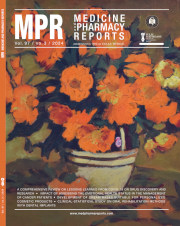Long-term results of multimodal treatment of the prostate using the Thulium Laser
DOI:
https://doi.org/10.15386/mpr-2760Keywords:
benign prostatic hyperplasia, non-anatomic technique, long-term results, thulium laserAbstract
Background and aims. To evaluate a novel multimodal treatment (TLP) that integrates the use of a thulium laser, bipolar transurethral resection of the prostate (TURP), and “button-type” bipolar plasma vaporization for the endoscopic treatment of benign prostatic hyperplasia (BPH).
Methods. From March 2018 to December 2021, we prospectively evaluated 220 patients with symptomatic BPH who underwent TLP. Patients were assessed based on the International Prostate Symptom Score (IPSS), quality of life (QoL), maximum urinary flow rate (Qmax), and postvoid residual urine (PVR). Perioperative and postoperative follow-up data were analyzed.
Results. The mean age at surgery was 66.74 years (SD 8.21). The median prostate size was 80 (IQR 70 - 110). The median operative time was 45 (IQR 35 - 55) minutes and the hospital stay was 2 (IQR 1 - 2) days. Patients were discharged with the urinary catheter in place, which was removed approximately 7 days after surgery when the histopathological result was discussed with the patient. Postoperatively, IPSS, QoL, Qmax and PVR showed a significant improvement starting at 3 months and continued through the postoperative follow-up visits (6- 12-24-36-48-60 months). Urethral stricture and bladder neck contracture occurred in 1 (0.45%) and 2 (0.91%) patients, respectively. Recurrence of BPH occurred in 2 patients (0.91%) who underwent a second procedure.
Conclusions. In conclusion, we report that the multimodal surgical treatment of BPH consisting of combining Thulium laser vaporization, bipolar TURP and plasma vaporization (TLP) represents an efficient and durable therapeutic method for BPH patients with low a complication rate at 5-year follow-up.
Downloads
Published
How to Cite
Issue
Section
License
The authors are required to transfer the copyright of the published paper to the journal. This is done by agreeing to sign the Copyright Assignment Form. Whenever the case, authors are also required to send permissions to reproduce material (such as illustrations) from the copyright holder.

The papers published in the journal are licensed under a Creative Commons Attribution-NonCommercial-NoDerivatives 4.0 International License.

